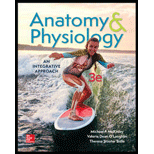
Anatomy and Physiology: An Integrative Approach with Connect Access Card
3rd Edition
ISBN: 9781260254440
Author: Michael McKinley, Valerie O'Loughlin, Theresa Bidle
Publisher: McGraw-Hill Education
expand_more
expand_more
format_list_bulleted
Question
Chapter 2.3, Problem 25LO
Summary Introduction
To define: The intermolecular attractions between nonpolar molecules.
Concept introduction:
Expert Solution & Answer
Want to see the full answer?
Check out a sample textbook solution
Students have asked these similar questions
"Which of the following about transposable elements (TEs) is false?"
RNA transposons move using an RNA intermediate.
DNA transposons make up 3% of the human genome but are disruptive.
Genes can move within the same chromosome via TEs.
The Drosophila P element can only move in germline cells.
Can you explain each answer choices pleae?
What will control the rate of bioremediation of petroleum? (Choose all correct answers)
The availability of the petroleum
The temperature of the water
The availability of oxygen
The percent of the population that has degraded petroleum in the past
Which of the following would lead to a false negative result in a sandwich ELISA (the lab manual refers to this as a direct ELISA- also known as search for antigen)? Mark all correct answers.
antibody was non-specific and bound to something other than the antigen of interest.
too short of a duration when incubating the reagents in the plate.
If there are multiple strains of the pathogen of interest and the antibody does not recognize one of the strains.
Did not sample the correct bodily fluid/area to detect the antigen
concentration of antigen was too low to detect in the patient sample.
inadequate washing was performed after the enzyme linked antibody was allowed to bind.
substrate was exposed to too much light
reusing a pipette that was used to pipette a positive sample.
Chapter 2 Solutions
Anatomy and Physiology: An Integrative Approach with Connect Access Card
Ch. 2.1 - Prob. 1LOCh. 2.1 - Prob. 2LOCh. 2.1 - Prob. 3LOCh. 2.1 - Prob. 4LOCh. 2.1 - Prob. 1WDTCh. 2.1 - What subatomic particles determine the mass of an...Ch. 2.1 - Diagram the atomic structure of chlorineatomic...Ch. 2.1 - Prob. 5LOCh. 2.1 - Prob. 6LOCh. 2.1 - Do isotopes represent the same element? Do they...
Ch. 2.1 - Prob. 7LOCh. 2.1 - Prob. 8LOCh. 2.1 - Prob. 4WDLCh. 2.2 - LEARNING OBJECTIVES
9. Define an ion.
Ch. 2.2 - LEARNING OBJECTIVES
10. List some common ions in...Ch. 2.2 - Prob. 11LOCh. 2.2 - Prob. 12LOCh. 2.2 - Prob. 2WDTCh. 2.2 - List the common cations and anions of the human...Ch. 2.2 - Prob. 6WDLCh. 2.2 - Explain how and why ions form based on the octet...Ch. 2.2 - Prob. 13LOCh. 2.2 - Prob. 14LOCh. 2.2 - Prob. 15LOCh. 2.2 - Could an ionic bond form between two cations or...Ch. 2.3 - LEARNING OBJECTIVES
16. Define a molecular...Ch. 2.3 - Prob. 17LOCh. 2.3 - Prob. 9WDLCh. 2.3 - What is an isomer?Ch. 2.3 - Prob. 18LOCh. 2.3 - Prob. 19LOCh. 2.3 - Prob. 20LOCh. 2.3 - Prob. 21LOCh. 2.3 - Explain covalent bond formation in terms of...Ch. 2.3 - Assign the partial charges between nitrogen and...Ch. 2.3 - Why are some covalent bonds nonpolar and others...Ch. 2.3 - Prob. 22LOCh. 2.3 - Prob. 23LOCh. 2.3 - WHAT DO YOU THINK?
3 Is the fatty acid portion of...Ch. 2.3 - Are O2, and CO2 nonpolar or polar molecules?Ch. 2.3 - Prob. 24LOCh. 2.3 - Prob. 25LOCh. 2.3 - What is the name of the intermolecular attraction...Ch. 2.4 - Prob. 26LOCh. 2.4 - What is the intermolecular bond that is...Ch. 2.4 - Prob. 27LOCh. 2.4 - Which property of water contributes to the need to...Ch. 2.4 - Prob. 28LOCh. 2.4 - Prob. 29LOCh. 2.4 - Prob. 30LOCh. 2.4 - How does the interaction of a nonelectrolyte and...Ch. 2.4 - How do phospholipid molecules interact with water...Ch. 2.5 - Prob. 31LOCh. 2.5 - Explain why water is neutral.Ch. 2.5 - Prob. 32LOCh. 2.5 - Which type of substance releases H+ when added to...Ch. 2.5 - Prob. 33LOCh. 2.5 - Prob. 34LOCh. 2.5 - Prob. 35LOCh. 2.5 - Prob. 4WDTCh. 2.5 - What is the general relationship of [H+] and pH?Ch. 2.5 - Why are buffers important and how do they function...Ch. 2.6 - Prob. 36LOCh. 2.6 - Prob. 37LOCh. 2.6 - Prob. 24WDLCh. 2.6 - Why is blood also considered the other two types...Ch. 2.6 - Prob. 38LOCh. 2.6 - What are four ways solution concentration may be...Ch. 2.7 - Prob. 39LOCh. 2.7 - Prob. 40LOCh. 2.7 - Prob. 41LOCh. 2.7 - Prob. 42LOCh. 2.7 - Prob. 27WDLCh. 2.7 - What functional groups may act as an acid?Ch. 2.7 - Prob. 29WDLCh. 2.7 - Prob. 43LOCh. 2.7 - Prob. 44LOCh. 2.7 - Do lipid molecules typically dissolve in water?...Ch. 2.7 - Which class of lipids forms cell membranes? What...Ch. 2.7 - Prob. 45LOCh. 2.7 - Prob. 46LOCh. 2.7 - Prob. 47LOCh. 2.7 - What is the repeating monomer of glycogen? Where...Ch. 2.7 - For each of the following, indicate if it is a...Ch. 2.7 - LEARNING OBJECTIVES
48. Describe the general...Ch. 2.7 - LEARNING OBJECTIVES
49. Describe the structure of...Ch. 2.7 - Prob. 50LOCh. 2.7 - Prob. 51LOCh. 2.7 - What is the general function of nucleic acids?Ch. 2.7 - What are the structural differences between RNA...Ch. 2.7 - Prob. 52LOCh. 2.7 - Prob. 53LOCh. 2.7 - What are the monomers of proteins and the name of...Ch. 2.8 - Prob. 37WDLCh. 2.8 - Prob. 54LOCh. 2.8 - Prob. 55LOCh. 2.8 - Prob. 56LOCh. 2.8 - Prob. 38WDLCh. 2.8 - Prob. 57LOCh. 2.8 - Prob. 58LOCh. 2.8 - Prob. 59LOCh. 2.8 - Prob. 5WDTCh. 2.8 - What distinguishes the tertiary and quaternary...Ch. 2.8 - What happens to a protein when it denatures? How...Ch. 2 - Prob. 1DYBCh. 2 - _____ 2. Substances that dissolve in water include...Ch. 2 - _____ 3. Temperature stabilization is dependent...Ch. 2 - _____ 4. All of the following are accurate about...Ch. 2 - _____ 5. Blood is a mixture that is more...Ch. 2 - Prob. 6DYBCh. 2 - _____ 7. Glucose is stored as which molecule...Ch. 2 - _____ 8. All of the following are common ions of...Ch. 2 - _____ 9. Intermolecular attractions between polar...Ch. 2 - _____ 10. When a protein permanently unfolds, it...Ch. 2 - List the common ions of the human body by name,...Ch. 2 - Describe a polar bond and a polar molecule.Ch. 2 - Diagram two water molecules and label the polar...Ch. 2 - Compare and contrast what occurs when a substance...Ch. 2 - Define the terms acid, base, PH, and buffers.Ch. 2 - Explain the units for expressing a concentration...Ch. 2 - Do You Know the Basics?
17. List the four...Ch. 2 - Prob. 18DYBCh. 2 - Describe how phospholipid molecules form the...Ch. 2 - Explain protein denaturation, including bow it...Ch. 2 - Which property of water is significant in children...Ch. 2 - Prob. 2CALCh. 2 - Prob. 3CALCh. 2 - The condition of rickets involves bones that have...Ch. 2 - The hormone insulin is a __________ composed of...Ch. 2 - Prob. 1CSLCh. 2 - The lab results from a diabetic patient show a...Ch. 2 - Prob. 3CSL
Knowledge Booster
Learn more about
Need a deep-dive on the concept behind this application? Look no further. Learn more about this topic, biology and related others by exploring similar questions and additional content below.Similar questions
- S. +1269 pts /1500 © Macmillan Learning 0 Resources Solution Penalized Feedback Try Again Draw the final product with stereochemistry and lone pairs. The leaving group has been pre-drawn for your convenience. +100 +100 : 0: + H,C- :0: : 0 0 : +100 +94 possible ✓ +100 K Attemparrow_forward+1269 pts /1500 © Macmillan Learning t/1188d950-dd73-11e0-9572-0800200c9a66/3045511b-267e-4a00-86ca-85dbc62ecb4e/6ac3a0c9-... a □ 出 All Bookmarks Due: Mon, May 26 Resources Solution Penalized Feedback Try Again KX Attempt 3 Draw the final product with stereochemistry and lone pairs. The leaving group has been pre-drawn for your convenience. :0: + нс H,C- :0: : 0:arrow_forwards. +1169 pts /1500 © Macmillan Learning 0 Resources Hint Submit Answer Step 3: This tertiary carbocation intermediate readily undergoes elimination with any weak base to form two possible products. + + H :0: H +94 possible 3a) Draw the minor organic product of elimination. Select Draw Templates More +100 +95 possible # C Major product + Minor product 3b) Draw the major organic product of elimination. Erase Select Draw Templates More C Erasearrow_forward
- Explain the Science & Society on (with links and pictures): ---- Question down below Discuss the ethical, medical, and societal implications of using advanced genetic techniques?arrow_forwardExplain the Disease Mechanism & Impact on (with links and pictures): What causes Leigh Syndrome and why it's so deadly. Which cellular functions, organelles (especially mitochondria), and macromolecules are involved.arrow_forwardExplain the Disease Mechanism & Impact on (with links and pictures): What's going wrong inside the cell and the effects on the human body. Describe metabolism with an emphasis on cellular respiration.arrow_forward
- Explain the Disease Mechanism & Impact on (with links and pictures):arrow_forwardExplain the Science & Society on (with links and pictures): Discuss the ethical, medical, and societal implications of using advanced genetic techniques.arrow_forward↑ LED Tt O Tt e 0 ✓ B > FLORES DIology Second Semester Review 7. Chi Square Analysis: wild dumpy male x ebony wild female F1: All wild wild F2: 142 wild wild males 52 wild ebony males 46 dumpy wild males 17 dumpy ebony males 151 wild wild females 47 wild ebony females 51 dumpy wild females 8 dumpy ebony females What pattern of inheritance is observed for body color? Autosomal recessive Autosomal dominant Sex-linked recessive Sex-linked dominant What are the genotypes of the parents in the P generation? a. XBYdd x XbXbDD b. Bbdd x bbDd c. BBdd x bbDD d. BBX Y x bbXDY How many flies in the F2 generation would you expect to express the dumpy wild phenotype? a. 289.125 b. 97 c. 96.375 d. 293arrow_forward
- 4. This question focuses on entrainment. a. What is entrainment? b. What environmental cues are involved in entrainment, and which one is most influential? c. Why is entrainment necessary? d. Assuming that a flash of darkness is an effective zeitgeber, what impact on circadian rhythms would you expect to result from an event such as the 2024 solar eclipse (assume it was viewed from Carbondale IL, where totality occurred at about 2 pm)? Explain your reasoning. You may wish to consult this phase response diagram. Phase Shift (Hours) Delay Zone Advance Zone Dawn Mid-day Dusk Night Dawn Time of Light Stimulus e. Finally, give a real-world example of how knowledge of circadian rhythms and entrainment has implications for human health and wellbeing or conservation biology. This example could be from your reading or from things discussed in class.arrow_forwardGenerate one question that requires a Punnet Squre to solve the question. Then show how you calculate the possibilities of genotype and phenotypearrow_forwardBriefly state the physical meaning of the electrocapillary equation (Lippman equation).arrow_forward
arrow_back_ios
SEE MORE QUESTIONS
arrow_forward_ios
Recommended textbooks for you
 Human Anatomy & Physiology (11th Edition)BiologyISBN:9780134580999Author:Elaine N. Marieb, Katja N. HoehnPublisher:PEARSON
Human Anatomy & Physiology (11th Edition)BiologyISBN:9780134580999Author:Elaine N. Marieb, Katja N. HoehnPublisher:PEARSON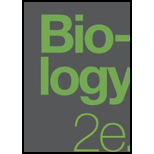 Biology 2eBiologyISBN:9781947172517Author:Matthew Douglas, Jung Choi, Mary Ann ClarkPublisher:OpenStax
Biology 2eBiologyISBN:9781947172517Author:Matthew Douglas, Jung Choi, Mary Ann ClarkPublisher:OpenStax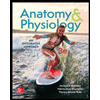 Anatomy & PhysiologyBiologyISBN:9781259398629Author:McKinley, Michael P., O'loughlin, Valerie Dean, Bidle, Theresa StouterPublisher:Mcgraw Hill Education,
Anatomy & PhysiologyBiologyISBN:9781259398629Author:McKinley, Michael P., O'loughlin, Valerie Dean, Bidle, Theresa StouterPublisher:Mcgraw Hill Education,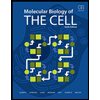 Molecular Biology of the Cell (Sixth Edition)BiologyISBN:9780815344322Author:Bruce Alberts, Alexander D. Johnson, Julian Lewis, David Morgan, Martin Raff, Keith Roberts, Peter WalterPublisher:W. W. Norton & Company
Molecular Biology of the Cell (Sixth Edition)BiologyISBN:9780815344322Author:Bruce Alberts, Alexander D. Johnson, Julian Lewis, David Morgan, Martin Raff, Keith Roberts, Peter WalterPublisher:W. W. Norton & Company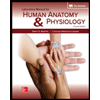 Laboratory Manual For Human Anatomy & PhysiologyBiologyISBN:9781260159363Author:Martin, Terry R., Prentice-craver, CynthiaPublisher:McGraw-Hill Publishing Co.
Laboratory Manual For Human Anatomy & PhysiologyBiologyISBN:9781260159363Author:Martin, Terry R., Prentice-craver, CynthiaPublisher:McGraw-Hill Publishing Co.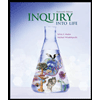 Inquiry Into Life (16th Edition)BiologyISBN:9781260231700Author:Sylvia S. Mader, Michael WindelspechtPublisher:McGraw Hill Education
Inquiry Into Life (16th Edition)BiologyISBN:9781260231700Author:Sylvia S. Mader, Michael WindelspechtPublisher:McGraw Hill Education

Human Anatomy & Physiology (11th Edition)
Biology
ISBN:9780134580999
Author:Elaine N. Marieb, Katja N. Hoehn
Publisher:PEARSON

Biology 2e
Biology
ISBN:9781947172517
Author:Matthew Douglas, Jung Choi, Mary Ann Clark
Publisher:OpenStax

Anatomy & Physiology
Biology
ISBN:9781259398629
Author:McKinley, Michael P., O'loughlin, Valerie Dean, Bidle, Theresa Stouter
Publisher:Mcgraw Hill Education,

Molecular Biology of the Cell (Sixth Edition)
Biology
ISBN:9780815344322
Author:Bruce Alberts, Alexander D. Johnson, Julian Lewis, David Morgan, Martin Raff, Keith Roberts, Peter Walter
Publisher:W. W. Norton & Company

Laboratory Manual For Human Anatomy & Physiology
Biology
ISBN:9781260159363
Author:Martin, Terry R., Prentice-craver, Cynthia
Publisher:McGraw-Hill Publishing Co.

Inquiry Into Life (16th Edition)
Biology
ISBN:9781260231700
Author:Sylvia S. Mader, Michael Windelspecht
Publisher:McGraw Hill Education
GCSE Chemistry - Acids and Bases #34; Author: Cognito;https://www.youtube.com/watch?v=vt8fB3MFzLk;License: Standard youtube license